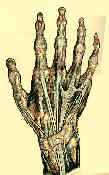- See:
- MP joint deformities
- Distal Ulna Arthroplasty
- Rheumatoid Hand
- Anatomical Contributing Factors: (to ulnar drift)
- normal mechanical advantage of the ulnar intrinsic muscles
- asymmetry & ulnar slope of MC heads of index & middle fingers;
- asymmetry of the collateral ligaments;
- ulnar forces applied on pinch and grasp;
- flexor tendons enter fibrous sheath at angle, exerting ulnar & palmar pull that is resisted in the normal hand;
- carpal collapse can cause radial deviation of the carpi leading to compensatory MP joint ulnar deviation;
- Pathology of Ulnar Drift:
- w/ rheumatoid involvement of MP joint, there will be weakening & elongation of MP capsule & ligaments;
- extensor tendon hoods are loosely fixed & vulnerable to disruption;
- as resistance to displacing forces is lost, extensor tendons are displaced in an ulnar and palmar directions;
- flexor tendons enter fibrous sheath at angle, exerting ulnar & palmar pull that is resisted in the normal hand;
- as a result base of proximal phalanx moves ulnarly and palmarly;
- role of the ECU tendon:
- increased mobility of fourth & fifth metacarpals, results from rheumatoid involvement of CMC joints & dysfunction of ECU; (caput ulnae);
- relative increase in tension of the radial wrist extensors contributes to wrist supination deformity;
- Surgical Indications:
- severe deformity w/ MCP dislocation or arthritis;
- Surgical Goals:
- this often results in pain relief, improved function, cosmesis, and delayed progression;
- patients should only expect limited improvement in motion, and no change in grip strength;
- Surgical Approach: 


- transverse incision over necks of metacarpals to expose extensor tendons;
- superficial veins and nerves preserved;
- note whether there is rupture of any of the extensor tendons;
- intrinsic release:
- prior to deep dissection, identify each portion of the extensor apparatus along the ulnar side of the digit;
- MP joint is usually entered along the ulnar side of the extensor tendon (through the saggital band);
- w/ ulnar deviation of MPJ long extensor tendon released by incising dorsal hood along tendon's ulnar margin, except in index and little fingers, where incision made between EDC and extensor digiti minimi tendons;
- an adequate intrinsic release should divide the transverse and oblique fibers;
- w/ only moderate deformity, consider release of only the oblique fibers;
- little finger:
- dorsal branch of digital nerve is protected;
- ADQ tendon is divided, after the FDQ has been protected;
- flexor digiti minimi brevis tendon preserved;
- Surgical Options:
- MCP silastic implants: w/ or w/o PIP fusion;
- intrinsic release: (see above)
- crossed intrinsic transfer: (ulnar drift)
- involves division of the intrinsics on the ulnar side of the wrist and transfer to the radial side;
- divide intrinsic tendons on ulnar side of index, middle, & ring fingers from their attachment to the extensor mechanism;
- consider rerouting tendons across adjacent web space, & then attaching them to the adjacent (radial) extensor hood, or alternatively the intrinsic tendons may be anchored into the radial collateral ligament (may potentially decrease chance of postoperative swan neck deformity);
- complications:
- may potentially worsen swan neck deformity
Extensor digiti minimi tendon transfer to prevent recurrent ulnar drift.

